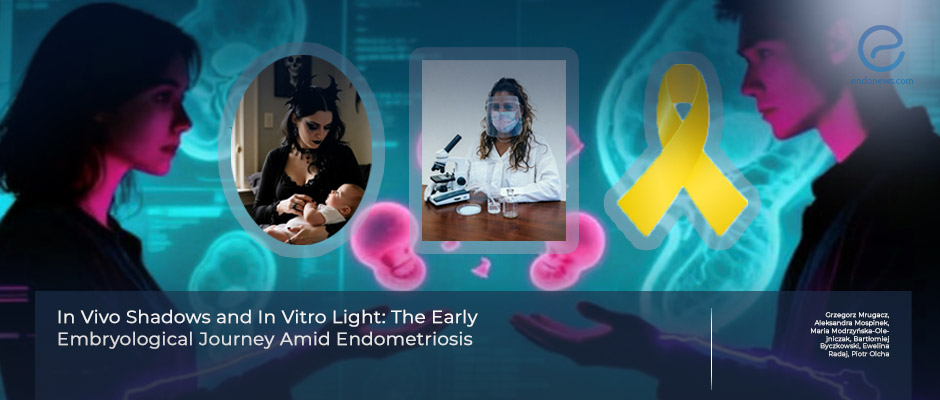From Damage to Hope: IVF and Embryo Science in Endometriosis
Oct 8, 2025
Endometriosis Creates a Hostile Reproductive Landscape That IVF Can Only Partly Repair
Key Points
Highlights:
- Endometriosis impairs fertility through chronic inflammation, oxidative stress, immune dysfunction, and structural damage to reproductive organs.
- IVF bypasses some of these “in vivo” barriers, offering a controlled environment for egg fertilization and embryo development, yet biological and technical challenges persist.
Importance:
- This comprehensive review elucidates the molecular, immunologic, and oxidative mechanisms of endometriosis-related infertility and critically examines how assisted reproductive technologies can mitigate—but not fully overcome—these effects.
Whats Done Here?
- This review is from the Center for Reproductive Medicine Bocian and the Medical University of Lublin, Poland.
- The authors reviewed and synthesized evidence on the pathophysiology of endometriosis, oocyte and embryo quality, IVF outcomes, and emerging innovations such as time-lapse imaging, single-cell transcriptomics, and AI-driven embryo selection.
Key Results:
- Endometriosis reduces ovarian reserve, alters follicular environments, and triggers oxidative DNA damage in oocytes and embryos.
- IVF improves fertilization and pregnancy rates by bypassing inflammatory and oxidative barriers but shows a 10–15% lower live birth rate compared with controls.
- Oocyte quality remains the principal limiting factor; uterine receptivity is often preserved.
- Pretreatment with GnRH agonists and antioxidants, as well as AI-assisted embryo selection, may optimize outcomes.
- Future strategies include integrating multi-omics profiling, immunomodulation, and exosome-based therapies to restore reproductive function.
Limitations:
- Despite robust synthesis, evidence heterogeneity and a lack of longitudinal, stage-specific IVF data limit definitive conclusions. Personalized ART strategies remain largely theoretical.
From the Editor-in-Chief – EndoNews
"This review stands out for connecting two previously fragmented fields — the molecular biology of endometriosis and the applied science of reproductive technology — within a unified analytical framework. It clearly illustrates how endometriosis creates a hostile “in vivo” microenvironment through oxidative stress, immune dysregulation, and mitochondrial damage, and how IVF offers a temporary “in vitro sanctuary” for conception.
Yet the message is not simply that technology compensates for disease. The authors argue persuasively that endometriosis-related infertility cannot be fully corrected by procedural sophistication alone. Oocyte competence, redox balance, and immune homeostasis remain the decisive determinants of reproductive success. Their synthesis also highlights an emerging paradigm: precision reproductive medicine, in which AI, metabolomics, and immune profiling could tailor IVF strategies to each woman’s unique biological profile.
In bridging the bench and the bedside, this paper redefines fertility not as a static outcome but as a dynamic biological equilibrium disturbed by disease and partially restored by innovation. It reminds us that the path forward will require translational synergy — not just better protocols, but deeper molecular understanding."
Lay Summary
Endometriosis remains one of the most challenging causes of infertility, affecting women both biologically and emotionally. In a comprehensive review published in Biology, Dr. Monika Mrugacz and colleagues examine how this disease disrupts fertility at every level: from the health of the oocyte to the complex signaling within the uterus.
The authors describe endometriosis as a condition that disturbs the body’s natural reproductive balance through inflammation, oxidative stress, and immune dysfunction.
These processes damage the eggs, impair embryo development, and alter the ovarian environment, ultimately making it more difficult for women to conceive naturally.
While in vitro fertilization (IVF) provides hope by bypassing some of these biological obstacles, the review highlights that IVF outcomes in women with endometriosis are still 10–15% lower than in women without the disease.
This difference is mainly due to reduced egg quality rather than uterine problems.
The paper also explores emerging innovations — including AI-assisted embryo selection, time-lapse imaging, and multi-omics profiling, that may one day personalize fertility care for women with endometriosis.
However, the authors caution that these tools remain in early development and require stronger clinical validation.
Overall, this review emphasizes a new frontier in endometriosis research: moving beyond treating symptoms to understanding the cellular and molecular mechanisms that define fertility potential. By integrating biology, technology, and clinical insight, the future of reproductive medicine may finally bridge the gap between the “shadows” of endometriosis and the “light” of IVF.
Research Source: https://pubmed.ncbi.nlm.nih.gov/40906150/
infertility endometriosis dysruption IVF egg concieve research molecular mechanism gap uterus

